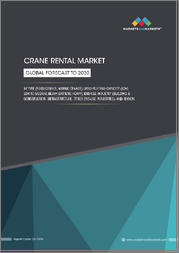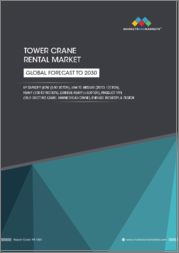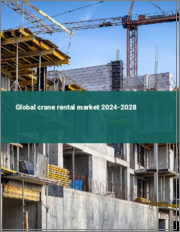
|
시장보고서
상품코드
1733665
크레인 렌탈 시장 : 유형별, 리프팅 중량, 최종사용자별, 지역별(2026-2032년)Cranes Rental Market by Type (Mobile Cranes, Fixed Cranes), Weight Lifting Capacity (Low, Low-Medium, Heavy, Extreme Heavy), End-User (Building & Construction, Marine & Offshore, Mining & Excavation, Oil & Gas, Transportation), & Region for 2026-2032 |
||||||
크레인 렌탈 시장 평가 - 2026-2032년
세계 크레인 렌탈 시장은 전 세계 건설 활동 증가, 특히 공간의 제약으로 인해 크레인 소유가 문제가 되는 도시 지역 증가에 의해 주도되고 있습니다. 기업은 비용을 절감하고 유지보수 문제를 방지하기 위해 크레인 대여를 선택합니다. 북미와 유럽은 인프라 투자가 활발하고 아시아태평양은 도시화와 산업화로 인해 크게 확장되고 있습니다. 이에 따라 시장 규모는 2024년에 509억 달러를 돌파하며, 2032년에는 706억 8,000만 달러에 달할 전망입니다.
이 시장은 경쟁이 치열하며, 유명 제조업체들이 이동식, 타워형, 크롤러 크레인 등 다양한 유형의 크레인을 제공합니다. 렌탈 서비스는 유연성과 비용 효율성으로 인해 인기가 높으며, 전 세계 건설 회사 및 인프라 개발업체들이 선호하고 있습니다. 아시아태평양 및 라틴아메리카의 신흥 경제 국가들은 건설 및 인프라 계획 증가로 인해 상당한 발전 잠재력을 가지고 있습니다. 크레인 렌탈 수요 증가로 인해 시장은 2026-2032년 동안 CAGR 4.62%를 보일 것으로 예측됩니다.
크레인 렌탈 시장 정의/개요
크레인 렌탈은 건설 현장이나 산업 작업, 행사 등에서 대형 자재를 들어 올리거나 이동시키기 위해 크레인을 일정 기간 중 임대하는 것을 말합니다. 렌탈 서비스는 이동식 크레인, 타워 크레인, 오버 헤드 크레인 등 다양한 유형의 크레인으로 구성되는 경우가 많으며, 소유할 필요 없이 유연하고 일시적인 리프팅 요구에 대한 비용 효율적인 솔루션을 설명합니다.
크레인 대여는 장기적인 지출 없이 일시적인 리프팅 솔루션을 필요로 하는 부문에 필수적입니다. 건설 업계에서는 대형 자재 리프팅, 물류업계에서는 화물 적재 및 하역, 이벤트 업계에서는 무대 설치에 필수적입니다. 크레인 대여는 유연성과 비용 효율성을 제공하며, 소유에 대한 부담 없이 변화하는 프로젝트 요구에 효율적으로 대응할 수 있습니다.
크레인 렌탈은 도시화, 인프라 계획, 전 세계 건축 활동의 확대로 인해 향후 수요가 증가할 것으로 예측됩니다. 자동화, 디지털 통합 등 크레인 기술의 발전으로 효율성과 안전성이 향상되어 비용 효율적이고 유연한 프로젝트 관리 솔루션으로 렌탈을 선택하게 될 것으로 보입니다.
인프라 구축의 진전이 크레인 렌탈 시장의 성장을 가속하는가?
인프라 개발 증가는 크레인 렌탈 사업의 성장 촉진에 필수적입니다. 도로, 교량, 공항, 에너지 인프라는 모두 건설, 정비 및 확장 단계에서 크레인과 같은 중량물 운반 기계의 사용이 필요합니다.
크레인 렌탈의 유연성으로 인해 프로젝트 관리자는 초기 비용 부담 없이 전문 장비를 사용할 수 있으므로 대규모 인프라 프로젝트나 국소적인 인프라 프로젝트에서 매력적인 선택이 될 수 있습니다.
또한 자동화 및 디지털 통합과 같은 크레인 기술 개발로 인해 효율성과 안전성이 향상되어 인프라 프로젝트에서의 활용이 가속화되고 있습니다. 전 세계 정부가 경제 성장을 가속하고 연결성을 향상시키기 위해 인프라 프로젝트에 중점을 두면서 크레인 렌탈 서비스에 대한 수요는 특히 도시화 및 산업화가 빠르게 진행되는 지역에서 증가할 가능성이 높습니다. 이러한 추세는 전 세계에서 크레인 렌탈 시장의 성장 궤도를 형성하는 데 있으며, 인프라 개발이 매우 중요한 역할을 하고 있음을 보여줍니다.
높은 초기 비용과 경제 불확실성이 크레인 렌탈 시장의 걸림돌이 되는가?
높은 초기 비용과 경제의 불안정성은 크레인 렌탈 부문에 도전이 될 수 있습니다. 새로운 크레인 구입에 필요한 막대한 초기 투자비용은 기업의 보유량 증가와 산업 진입을 저해할 수 있습니다.
또한 금리 상승과 지정학적 불안정성과 같은 경제의 불확실성은 건설 활동과 인프라 투자에 영향을 미쳐 크레인 임대 수요에 영향을 미칠 수 있습니다. 이러한 장애물에도 불구하고 리스 모델은 유연성, 유지보수 비용 절감, 첨단 기술에 대한 접근성 등의 이점을 제공하여 기업의 재무적 위험을 줄이는 데 도움이 될 수 있습니다.
또한 렌탈 서비스를 통해 기업은 프로젝트의 필요에 따라 보유 대수를 늘릴 수 있으며, 비용 효율성을 높일 수 있습니다. 크레인 렌탈 회사는 서비스 범위를 넓히고, 고객 지원을 개선하고, 기술 혁신에 투자함으로써 시장의 회복력을 유지하고 새로운 기회를 활용하여 경제적 도전에 효율적으로 대응할 수 있습니다.
목차
제1장 서론
- 시장의 정의
- 시장 세분화
- 조사 방법
제2장 개요
- 주요 조사 결과
- 시장 개요
- 시장 하이라이트
제3장 시장 개요
- 시장 규모와 성장 가능성
- 시장 동향
- 시장 성장 촉진요인
- 시장 성장 억제요인
- 시장 기회
- Porter's Five Forces 분석
제4장 크레인 렌탈 시장 : 크레인 유형별
- 이동식 크레인
- 고정 크레인
제5장 크레인 렌탈 시장 : 리프팅 중량별
- 경량
- 경·중량
- 중량
- 초중량
제6장 크레인 렌탈 시장 : 최종사용자별
- 건축·건설
- 해양·오프쇼어
- 채광·굴착
- 석유 및 가스
- 운송
제7장 지역 분석
- 북미
- 미국
- 캐나다
- 멕시코
- 유럽
- 영국
- 독일
- 프랑스
- 이탈리아
- 아시아태평양
- 중국
- 일본
- 인도
- 호주
- 라틴아메리카
- 브라질
- 아르헨티나
- 칠레
- 중동 및 아프리카
- 남아프리카공화국
- 사우디아라비아
- 아랍에미리트
제8장 시장 역학
- 시장 성장 촉진요인
- 시장 성장 억제요인
- 시장 기회
- 시장에 대한 COVID-19의 영향
제9장 경쟁 구도
- 주요 기업
- 시장 점유율 분석
제10장 기업 개요
- Ainscough Crane Hire
- Al Faris
- Barnhart Crane and Rigging
- Bigge Crane and Rigging Co.
- Mammoet(SHV Holding)
- Maxim Crane Works, L.P.
- Sarens NV
- Sims Crane & Equipment
- TAT HONG HOLDINGS LTD
- TNT Crane & Rigging
제11장 시장 전망과 기회
- 신규 기술
- 향후 시장 동향
- 투자 기회
제12장 부록
- 약어 리스트
- 공급원과 참고 문헌
Cranes Rental Market Valuation - 2026-2032
The global crane rental market is being driven by increasing construction activity globally, particularly in urban locations where space limits make owning cranes problematic. Companies choose to rent cranes to save money and prevent maintenance issues. North America and Europe lead due to substantial infrastructure investments, whilst Asia-Pacific is experiencing significant expansion as a result of urbanization and industrialization. This is likely to enable the market size surpass USD 50.9 Billion valued in 2024 to reach a valuation of around USD 70.68 Billion by 2032.
The market is characterized by a competitive landscape, with prominent manufacturers offering a wide range of crane types, including mobile, tower and crawler cranes. Rental services are popular because of their flexibility and cost-effectiveness, making them desirable to building enterprises and infrastructure developers around the world. Emerging economies in Asia-Pacific and Latin America provide considerable development potential due to an increase in construction and infrastructure initiatives. The rising demand for cranes rental is enabling the market grow at a CAGR of 4.62% from 2026 to 2032.
Cranes Rental Market: Definition/ Overview
Crane rental is the leasing of cranes for certain periods of time to lift and move big materials on construction sites, industrial operations or events. Rental services often comprise a variety of crane types, such as mobile, tower, and overhead cranes, giving flexibility without the requirement for ownership and cost-effective solutions for temporary lifting needs.
Crane renting is vital for sectors that want temporary lifting solutions without long-term expenditures. It's essential in construction for lifting big materials, logistics for loading and unloading freight and events for establishing stages. Crane rental provides flexibility and cost-effectiveness, meeting fluctuating project needs efficiently without the burden of ownership.
Crane rentals will see higher demand in the future as a result of urbanization, infrastructure initiatives and worldwide building activity expansion. Advancements in crane technology, such as automation and digital integration, will improve efficiency and safety, making rentals the preferred option for cost-effective and flexible project management solutions.
Will Increasing Infrastructure Development to Boost the Cranes Rental Market Growth?
Increasing infrastructure development is critical to driving growth in the crane rental business. Roads, bridges, airports and energy infrastructure all necessitate the use of heavy lifting equipment such as cranes throughout construction, maintenance, and expansion phases.
Crane rentals' flexibility allows project managers to have access to specialist equipment without incurring upfront fees, making them an appealing alternative for both large-scale and localized infrastructure undertakings.
Furthermore, technical developments in cranes, such as automation and digital integration, improve efficiency and safety, accelerating their use in infrastructure projects. As governments around the world emphasize infrastructure projects to drive economic growth and improve connectivity, demand for crane rental services is likely to increase, particularly in places undergoing fast urbanization and industrialization. This trend underlines the pivotal role of infrastructure development in shaping the cranes rental market's growth trajectory globally.
Will High Initial Costs and Economic Uncertainty Hamper the Cranes Rental Market?
High initial costs and economic instability can provide challenges for the crane rental sector. The considerable upfront investment necessary to purchase new cranes may discourage enterprises from extending their fleets or entering the industry.
Economic uncertainty, such as rising interest rates or geopolitical instability, may also have an impact on construction activities and infrastructure investments, influencing demand for crane rentals. Despite these obstacles, the leasing model provides benefits like as flexibility, lower maintenance costs and access to sophisticated technology, which can help firms lessen some of their financial risks.
Furthermore, rental services enable businesses to scale their fleet size dependent on project need, resulting in cost-efficiency. Crane rental companies can efficiently withstand economic challenges by broadening their service offerings and improving customer support, and investing in technological innovations to maintain market resilience and capitalize on emerging opportunities.
Category-Wise Acumens
Will Increasing Demand for Mobility and Ability to Operate in Diverse Terrains Drive the Type Segment?
The growing desire for mobility and the capacity to operate in a variety of terrains are important drivers for the mobile crane section of the crane rental market. Mobile cranes, which include truck-mounted, rough-terrain, and all-terrain varieties, provide exceptional versatility in navigating various construction sites and infrastructure projects efficiently. Their capacity to quickly mobilize and set up, combined with adaptable lifting powers, makes them indispensable for projects that require rapid deployment and versatility.
Furthermore, as urbanization accelerates and building activities move into increasingly challenging situations, such as distant areas or uneven terrain, the demand for mobile cranes grows. These factors highlight mobile cranes' vital role in addressing changing project requirements and generating growth within the crane rental market, positioning them as a dominating category.
Will Increasing Extensive Use of Cranes in Various Construction Activities Drive the Building & Construction Segment?
The growing use of cranes in various construction activities have a substantial impact on the building and construction market. Cranes are essential for lifting large materials, installing structural components and facilitating efficient construction operations on a wide range of projects, including high-rise structures, infrastructure development and residential complexes.
Crane rentals are very advantageous for construction organizations due to their flexibility and scalability, which allows them to meet shifting project needs without the long-term commitment and upfront expenditures associated with acquiring equipment. As global urbanization accelerates and infrastructure demands rise, cranes become increasingly important for completing construction projects quickly and safely.
Technological advances in crane design and functionality continuously enhance their efficiency and safety, reaffirming their essential role in current construction practices and ensuring sustained growth in the building and construction industry segment of the cranes rental market.
Country/Region-wise Acumens
Will Increasing Significant Infrastructure Development and Construction Activities Drive the Market in North America?
North America's crane rental market will continue to be driven by considerable infrastructure development and construction activities. The region's robust growth is being driven by continued investments in infrastructure rehabilitation, urban development initiatives, and industrial facility expansions.
These conditions produce a high need for cranes, which are used to efficiently lift and move big objects and equipment. Furthermore, the move toward urbanization and the restoration of aged infrastructure fuels this demand. Companies in North America are increasingly turning to crane rentals for the flexibility, cost-effectiveness and specialized expertise they provide, allowing project managers to scale operations as needed without the initial investment and maintenance costs associated with owning cranes outright. As construction activity increase, so will the reliance on crane rental services to meet evolving project requirements across various sectors.
Will Increasing Rapid Urbanization and Industrialization Drive the Market in Asia Pacific Region?
Rapid urbanization and industrialization are pushing the crane rental business in Asia-Pacific. As countries such as China, India and Southeast Asia experience fast urbanization and industrial growth, the need for construction and infrastructure projects rises. This growth needs effective and scalable lifting solutions from crane rentals.
Also, urbanization necessitates the modernization of current infrastructure as well as the construction of new residential, commercial and industrial complexes, all of which require heavy lifting equipment. Crane rentals provide flexibility, cost-effectiveness, and access to cutting-edge technology, making them popular choices in dynamic and rapidly rising markets.
Furthermore, government programs that promote infrastructure development exacerbate the demand for cranes. As metropolitan centers expand and industrial zones increase, the Asia-Pacific region remains a crucial growth sector for the cranes rental industry.
Competitive Landscape
The cranes rental market is a dynamic and competitive space, characterized by a diverse range of players vying for market share. These players are on the run for solidifying their presence through the adoption of strategic plans such as collaborations, mergers, acquisitions, and political support. The organizations are focusing on innovating their product line to serve the vast population in diverse regions.
Some of the prominent players operating in the cranes rental market include:
Ainscough Crane Hire
Al Faris
Barnhart Crane and Rigging
Bigge Crane and Rigging Co.
Mammoet (SHV Holding)
Maxim Crane Works, L.P.
Sarens NV
Sims Crane & Equipment
TAT HONG HOLDINGS LTD
TNT Crane & Rigging
Latest Developments
In October 2023 Barnhart Crane & Rigging, based in the US, acquired Bollmeyer Cranes from Madison, Illinois. Bollmeier Crane specializes in rental properties, equipment, and labor.
In March 2024, JCB expanded its footprint in destination equipment by introducing the T65D, a 65-foot diesel-powered machine for the North American rental market.
Cranes Rental Market, By Category
- Type:
- Mobile Cranes
- Fixed Cranes
- Weight Lifting Capacity:
- Low
- Low-Medium
- Heavy
- Extreme Heavy
- End-User:
- Building & Construction
- Marine & Offshore
- Mining & Excavation
- Oil & Gas
- Transportation
- Region:
- North America
- Europe
- Asia-Pacific
- South America
- Middle East & Africa
TABLE OF CONTENTS
1. Introduction
- Market Definition
- Market Segmentation
- Research Methodology
2. Executive Summary
- Key Findings
- Market Overview
- Market Highlights
3. Market Overview
- Market Size and Growth Potential
- Market Trends
- Market Drivers
- Market Restraints
- Market Opportunities
- Porter's Five Forces Analysis
4. Cranes Rental Market, By Type of Crane
- Mobile Cranes
- Fixed Cranes
5. Cranes Rental Market, By Weight Lifting Capacity
- Low
- Low-Medium
- Heavy
- Extreme Heavy
6. Cranes Rental Market, By End-user Industry
- Building & Construction
- Marine & Offshore
- Mining & Excavation
- Oil & Gas
- Transportation
7. Regional Analysis
- North America
- United States
- Canada
- Mexico
- Europe
- United Kingdom
- Germany
- France
- Italy
- Asia-Pacific
- China
- Japan
- India
- Australia
- Latin America
- Brazil
- Argentina
- Chile
- Middle East and Africa
- South Africa
- Saudi Arabia
- UAE
8. Market Dynamics
- Market Drivers
- Market Restraints
- Market Opportunities
- Impact of COVID-19 on the Market
9. Competitive Landscape
- Key Players
- Market Share Analysis
10. Company Profiles
- Ainscough Crane Hire
- Al Faris
- Barnhart Crane and Rigging
- Bigge Crane and Rigging Co.
- Mammoet (SHV Holding)
- Maxim Crane Works, L.P.
- Sarens NV
- Sims Crane & Equipment
- TAT HONG HOLDINGS LTD
- TNT Crane & Rigging
11. Market Outlook and Opportunities
- Emerging Technologies
- Future Market Trends
- Investment Opportunities
12. Appendix
- List of Abbreviations
- Sources and References


















